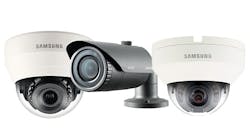With ever-increasing video resolution, there is no doubt that H.265 compression is the future. The growing demand for 4K and higher-megapixel video is driving the adoption of H.265 relatively quickly, as improvements in image quality, bandwidth efficiency and storage reduction are so compelling.
However, despite the demand for H.265-enabled cameras, some manufacturers have chosen to take a slower, more cautious approach – most likely in an effort to protect their existing product lineup for as long as possible. Alternatively, other manufacturers have taken a forward-looking approach to H.265 and are moving quickly to incorporate this powerful new compression format into their offerings. The rationale is simple: H.265’s capabilities match the present and future needs of today’s security professionals.
When H.264 was introduced in 2003, the most advanced IP digital cameras were VGA, which is at the lower end of the resolution spectrum. The bandwidth savings at that time were relatively small, but they have grown as megapixel cameras have come to dominate the market. H.264, however, was not designed to handle the extremely large file sizes of Ultra-HD (UHD) and other higher-resolution video. With this in mind, making the move from MJPEG to H.264 in 2003 did not offer tremendous advantages. By comparison, the savings in bandwidth and storage costs that H.265 delivers compared to H.264 are much greater when applied to 4K video than with 1080p (HD) cameras – about 75 percent compared to 25 percent.
With the prevalence of 5 megapixel cameras and the growth of 4K and other higher-resolution video formats, there is some hesitation on the part of many end-users to upgrade to these cameras without more efficient compression than H.264 provides. It is difficult for users to justify the added costs associated with beefing up their networks or adding storage to accommodate these video formats.
Thus, it is no longer a question of if, but when, H.265 will supplant H.264 as the de facto video compression standard for IP video security – a position H.264 has enjoyed for more than a decade. H.265 simply makes it more realistic and cost-effective to deploy higher-resolution cameras without added infrastructure expenses.
H.265 is the result of several best practices identified and employed by the experts, associations and others who have worked for the last few years to develop the protocol. Taking advantage of the latest cutting-edge processing and storage technologies, H.265 is purpose-built to deliver maximum efficiency bandwidth and storage reductions.
A number of manufacturers are already leading the charge to adopt H.265 compression, and the security industry will see the continued development of more advanced, higher-resolution, high-performance cameras moving forward.
With H.265, users can either send more video data over their existing architecture or receive the same information content they currently enjoy with much lower infrastructure requirements and costs. As a result, the next generation of superior video quality and performance is now more easily within reach for more and more customers and budgets.
Those integrators who take the time to learn and understand these keys to transitioning from H.264 to H.265 will be in the best position to help their customers reap the benefits of being on the leading edge of video technology and security – both today and well into the future.
Selling the Change
Now that there is a more efficient compression technology, it is important for integrators to know how to make the case for H.265 to their customers and perform the necessary upgrades to bring its benefits to fruition.
From a technology standpoint, the best strategy for making the transition to H.265 is to deploy cameras that support a triple codec, which enables customers to use H.264 and MJPEG today and provide the ability to take advantage of the benefits of H.265 compression in the future.
Implementing an H.265 system – whether for a new install or system upgrade – requires more than just cameras equipped with H.265 encoders, but also needs recording and VMS solutions capable of supporting this new compression technology.
When deploying 4K cameras, customers can realize significant bandwidth and storage savings vs. a conventional H.264 system. Customers can calculate their storage and bandwidth requirements by comparing H.265 and 4K video vs. H.264 and 1080p video. This is an important selling point because many customers have been led to believe that if they upgrade to 4K cameras, they will see their bandwidth and storage needs quadruple, and they will need to add more switches to their network.
In terms of specific applications and deployments, the scope of the installation – as well as the cost and potential savings – will vary from one project to the next. So before jumping in and recommending H.265, it is important for integrators to understand that particular customer’s specific needs and surveillance objectives, and be very familiar with their existing infrastructure and equipment.
Complete System Upgrades
A full upgrade of an existing system runs a close second to installing a completely new system in terms of the size and complexity of a project. If wiring and cabling needs to be replaced to accommodate the upgrade, the expense can easily outpace that of a new system. It goes without saying that these projects require careful planning to avoid additional, unexpected costs.
When there is no option other than ripping and replacing an existing system, the costs may be high, which will likely cause customers to be hesitant to go through with the upgrade. Understanding this, integrators must present the transition to H.265 as an investment in a system with a long lifecycle, as opposed to the relatively shorter shelf life of H.264 systems.
The best-case scenario for a full system upgrade is when the existing wiring infrastructure is in good condition. This makes it highly likely that the cameras, recorders and VMS can be upgraded to H.265-capable devices to deliver all the benefits of 4K and higher-resolution video at a fraction of the cost of either a new system or a complete rip-and-replace upgrade.
Partial System Upgrades
In some cases, partially upgrading a system or adding a new section onto an existing system makes the most sense for end-users. Generally speaking, new H.265 devices will be capable of using the older H.264 protocols for a period of time, which will be determined on trends in the security industry. This enables end-users to make the most of their current infrastructure investment while planning to take advantage of the benefits of H.265 down the road – a particularly attractive proposition for your customers who are working within tight budgets.
For example, it is quite possible for end-users to continue to use their existing H.264 NVRs while replacing older cameras with newer models with both H.264 and H.265 capability. Once budgets allow, the NVRs can be upgraded to newer models and cameras can be reset to operate using the H.265 protocol.
Similarly, a surveillance system can be extended, for example, to incorporate a newly constructed addition, using equipment with H.265 capability which can be integrated into the existing system using H.264 for the time being.
New System Installation
Any newly constructed facility requires an all-new surveillance system. In these cases, it does not make sense to install a system that relies on H.264 when the advantages of H.265 are so apparent. For this reason alone, integrators should recommend and make the best case for installing new end-to-end H.265 systems. It is much less expensive to install the appropriate infrastructure – such as signal wiring and power taps – when deploying a new system during construction than it will be to perform the eventual upgrade in the future.
Deploying H.265 cameras and recorders will not cost any more than H.264-based equipment today, and the infrastructure savings using H.265 devices should provide a savings for all but the smallest video surveillance systems; therefore, when specifying H.265 systems, it is important for integrators to use full system costs – including infrastructure – when presenting their recommendations to customers.
Tom Cook is Vice President of Sales, North America for Hanwha Techwin America. To request more info about the company, visit www.securityinfowatch.com/10215711.





